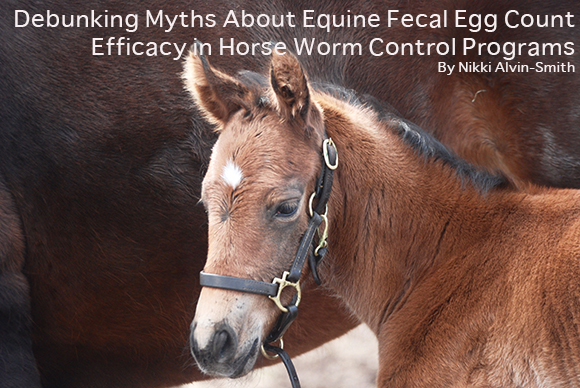Debunking Myths About Equine Fecal Egg Count Efficacy in Horse Worm Control Programs By Nikki Alvin-Smith
There is a lot of misinformation circulating about the best methods to control worms in horses, how to properly collect fecal samples for testing and how to analyze the results. When in doubt I always figure, ask an expert. So we sat down with equine parasitology specialist John Byrd DVM, of Horsemen’s Laboratory, to see if we could debunk some of the myths swirling around on the topic of targeted worm control.
 Dr. Byrd keenly follows the advice of world-renowned experts in the field of equine parasite control, Martin K. Nielsen DVM., PhD, DipACVM, (Gluck Equine Research Center, University of Kentucky) and Dr. Craig R. Reinemeyer, DVM, PhD, DipACVM (East Tennessee Clinical Research, Rockwood, TN). Additionally, through his business Horsemen’s Laboratory, that offers horse owners direct horse worm control testing services and one-on-one veterinary advice with full reports, Dr. Byrd has tested over 75,000 equine fecal samples for worm egg counts from across the USA and Canada, and is a valuable resource in the world of targeted horse worm control for professional and amateur horse owners alike.
Dr. Byrd keenly follows the advice of world-renowned experts in the field of equine parasite control, Martin K. Nielsen DVM., PhD, DipACVM, (Gluck Equine Research Center, University of Kentucky) and Dr. Craig R. Reinemeyer, DVM, PhD, DipACVM (East Tennessee Clinical Research, Rockwood, TN). Additionally, through his business Horsemen’s Laboratory, that offers horse owners direct horse worm control testing services and one-on-one veterinary advice with full reports, Dr. Byrd has tested over 75,000 equine fecal samples for worm egg counts from across the USA and Canada, and is a valuable resource in the world of targeted horse worm control for professional and amateur horse owners alike.
Here’s what Dr. Byrd had to say. I believe you will find it most enlightening.
CH: As many horse owners are aware, certain internal parasites in horses are becoming increasingly resistant to dewormers. I believe the latest protocol/advice from the AAEP is to utilize the equine fecal egg count test (FECT) to determine which dewormers to administer and when. Is it true that rotational deworming is causing dewormer resistant worms?
Dr. Byrd: There are many things that have contributed to the development of resistance in equine parasites to certain drugs. Rotation of drugs used, still causes the parasites to be exposed to certain classes of drugs at least 2-4 times per year depending on the interval between dewormings. A certain group of parasites may have been 80 % sensitive to the drug the first time it was used so 20% of the population was left to mate with each other causing a higher percentage the next generation to be resistant to the drug the next time it was used. After using the drug several times the population has become nearly 100% resistant to the drug. Once the population becomes resistant it never goes back to being sensitive to the drug.
For example: Dr. Nielsen says they have a group of horses at the University of Kentucky where the small strongyles in the herd developed resistance to the drug class benzimidazoles 40 years ago and these small strongyles are still resistant to that class of drugs today even though that class of drug has not been used in the herd in the last 40 years. The fact once a population of parasites has become resistant it will remain resistant is the reason it is critical that we do everything we can to slow the development of resistance to the drugs we have that are still useful.
CH: Based on your many years of experience in this specialty, do you feel this advice is still the best protocol to follow versus rotational deworming and will it resolve the resistance issue in your professional opinion? Can you please explain in layman’s terms.
Dr. Byrd: As Dr. Neilsen states in his book, “Drug rotation is no substitute for routine testing for anthelmintic (drug) resistance on the farm or stable”.
As stated in the previous answer once resistance has developed to a drug it will not resolve. That drug is not effective against that strain of parasite and indications are it will never be effective again against that strain of parasite. 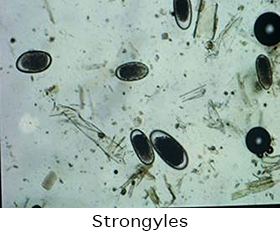
CH: Which types of worms should we be concerned about in particular concerning resistance to existing dewormers available?
Dr. Byrd: Small Strongyles in horses of all ages and roundworms in weanling, yearlings up to 3 years old. Resistance to Ivermectin and Quest (moxidectin) seem to be developing in pinworms.
CH: Can you tell us which worms you can test for with an FECT? And which worms cannot be detected with FECT? For the latter what testing is available from Horsemen’s Laboratory?
Dr. Byrd: Strongyle eggs are easily found in FECT. However, we cannot tell whether the eggs are from large or small strongyles, their eggs all look very much alike. In order to tell which eggs are from large strongyles and which are from small strongyles the eggs have to hatch and then the larva can be identified as being large or small strongyle larvae. Since we will treat them both with the same medication it does not really matter which the eggs are from. 35% of the samples we have examined are positive and of those positive samples over 95% are positive for strongyles. It is believed that over 95% those strongyle eggs are from small strongyles. Ivermectin is thought to have nearly eliminated large strongyles. Since strongyles are still the most common intestinal parasite in horses they are the primary parasite to base a horse’s worm control program upon.
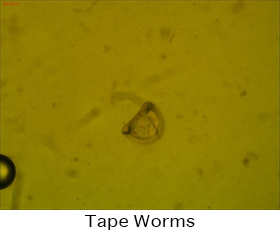 Roundworms are also easy to identify but generally only found in samples from horses less than 3 years of age with the younger horses having the heaviest infections.
Roundworms are also easy to identify but generally only found in samples from horses less than 3 years of age with the younger horses having the heaviest infections.
Tapeworms can also be found rarely in the routine FECT but the routine FECT is not very effective at determining tapeworm infections.
CH: There is some media circulating that suggests that sampling manure and then mailing the sample may subject it to heat that can cause eggs to hatch and that larvae are not detectible in egg count flotation techniques? Is this true?
Dr. Byrd: I must disagree with that viewpoint. We have been doing FECT on samples mailed to us since 1991. Yes, when we first started a fair number of samples contained eggs that had hatched but we were able to generally find many larvae either floating or actively swimming in the solution so we just counted each larvae we found as an egg. However about 10 years ago I met Dr. Nielsen and I asked him why when we received samples that all came in the same envelope some samples contained some eggs that had embryonated or hatched, while other samples the eggs appeared as they had just been passed from the horse.
He said that the eggs need exposure to oxygen in order for the larvae to develop and hatch. After that we strongly recommended to our clients always collect a fresh sample and pack the sample container firmly full. Since then (over ten years), we rarely have a sample with larvae or embryonated eggs even though occasionally we receive samples that have been in the mail for 2 weeks and all the eggs appear as they were just passed from the horse.
CH: Is it true or false that oxygen causes worm eggs to hatch? If so how should a FECT sample be taken?
Dr. Byrd: I am not sure I would say oxygen causes the eggs to hatch but rather the eggs need exposure to oxygen in order for the larva to develop and hatch.
One may collect the sample from the stall first thing in the morning if the horses are stalled separately overnight. Just pick the freshest sample in the stall and pack the sample container as firmly full as possible. When firmly packed there is very little oxygen in the container for the sample to be exposed to. Some tips for how to get your horse to give you a fresh sample include the following:
• If the horse is in a pasture with other horses put in a stall often the horse will be a little nervous and pass a stool within just a few minutes
• Some owners say loading their horse in the trailer does the trick.
• Taking the horse for a short walk away from the other horses often seems to be enough to stimulate a bowel movement.
CH: Is it true that FECT only works in monitoring eggs in the environment and useful only for herd health but not as a monitoring method for individual horses? I have heard this said but don’t understand it.
Dr. Byrd: This is not really true because one of the important things we are trying to do by doing FECT is to establish what egg shedding category a horse fits into i.e. low shedder (neg to 200 eggs/gm), medium shedder (200- 500 eggs /gm), high shedder (more than 500 eggs/gm). The category a horse fits in determines how often it should be dewormed throughout the year. Most horses seem to stay in the category once it is established where they fit.
Doing FECT not only determines the category but also indicates what worms a horse and its pasture mates may have. For instance, we spoke about tapeworms. If we find any tapeworm eggs in a horse’s sample, we not only know that that horse has tapeworms but the pasture also is contaminated with tapeworm eggs thereby exposing all the horses in a pasture to tapeworms. This bit of information can also help determine when the best time of year is to deworm.
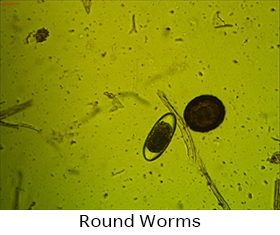 In a young horse FECT can indicate how heavily infected they are with roundworms. FECT can also indicate whether horses are harboring resistant worms to the deworming medication used. FECT can also indicate any horse that may have spit the deworming medication out.
In a young horse FECT can indicate how heavily infected they are with roundworms. FECT can also indicate whether horses are harboring resistant worms to the deworming medication used. FECT can also indicate any horse that may have spit the deworming medication out.
CH: Is it true to say that by the time worm eggs are detected in an equine fecal sample, the damage is already done and that FEC testing is not timely enough to work well?
Dr. Byrd: There is a saying better late than never. That is the way I think about that question and people that think that way. We have our testing program based on the old schedule most people used to use to deworm. The difference is that doing FECT gives the owner factual information, so they can make informed decisions about their horses’ worm control programs. Rather than just guessing when to deworm and then hoping it worked rather than knowing that the odds were good it was going to work. Because they knew what worms were present and had an idea how severely their horse was infected. Doing FECT can also give an owner the peace of mind that the treatment did work.
CH: Is it true that horses that compete or are under high stress may have weakened immune systems that allow worm counts to be higher than normal? Can you explain what role immunity plays in horse worms counts?
Dr. Byrd: I think this is a hard question to answer. Certainly many horses that are competing and traveling a lot when endoscopically examined are found to have ulcers in their stomachs. How much the immune system is stressed during this time may be difficult to determine. However, when the horses are stressed from other medical conditions the egg counts often go up. For instance, weanling and yearling often seem to have viral respiratory infections and high egg counts simultaneously. However this also is hard to evaluate because it may be just that the worms are at point of maturity where they are producing the most eggs. It also takes a certain length of time for the immune system to get developed to the point that it protects young horses from worms. The thought is that the immune system does play an important in parasite control. This fact seems to be illustrated by the following two examples:
• Round worms become nearly none existent in horses as they age. We credit the immune system for this.
• Strongyles egg counts vary widely in horses in the same pasture that are exposed to the same number of infective larvae yet some horses will maintain a negative to a very low egg count while others will have very high egg counts. Again it seems the immune system likely is responsible.
CH: In your expert opinion, is FECT part of an effective horse worm control program or is it a total solution?
Dr. Byrd: A good worm control program has four basis parts to it, diagnosis, treatment, prevention and monitoring. Dr. Nielsen states in his book, “Fecal egg counts remain the cornerstone of equine diagnostic parasitology”. Fecal egg counts are also very important in monitoring how well your horses’ parasite control program is working. Fecal egg counts can also give you information about treatment as far as when to treat and what to use determined by what worms are present. Fecal egg counts can also give you information on how well the preventive part of your horses’ worm control program is working.
CH: As an experienced horseman as well as practicing vet with extensive experience in the world of equine parasitology, what do you advise is the best practice for horse owners to adopt? Perhaps you could address this in the following categories listed?
Dr. Byrd: I will give some general information concerning each category, however each situation has many different factor that can effect what needs to be done for each category.
Mares immediately following parturition
 Dr. Byrd: This is a difficult question to answer because there are so many variables that must be considered. I would recommend following the same schedule of doing fecal egg counts as any other adult horse. First try to establish into what egg shedding category the mare appears to fit. With one of the tests being done one month before mare is due to have her foal. As far as deworming is concerned I would follow the same schedule for any other adult horse, which would be determined what egg shedding category the mare fits. 1-2 times/ year for low shedders, 2-3 times/ year for medium shedders, 4 times a year for high shedder. The medication used each time would be determined by the fecal egg count results.
Dr. Byrd: This is a difficult question to answer because there are so many variables that must be considered. I would recommend following the same schedule of doing fecal egg counts as any other adult horse. First try to establish into what egg shedding category the mare appears to fit. With one of the tests being done one month before mare is due to have her foal. As far as deworming is concerned I would follow the same schedule for any other adult horse, which would be determined what egg shedding category the mare fits. 1-2 times/ year for low shedders, 2-3 times/ year for medium shedders, 4 times a year for high shedder. The medication used each time would be determined by the fecal egg count results.
Foals
Dr. Byrd: As everyone probably already knows foals are definitely the category listed here that is most likely affected by intestinal worms (parasites). Round worms are often found in foals. Fecal egg counts should be done in foals starting at 3-4 months of age. Fecal eggs counts are important for foals so that the owner knows what adult worms are present and how heavily infected the foals are. The priority for treatment should be the roundworms.
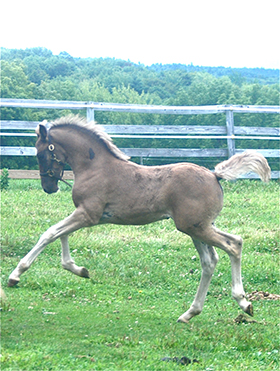 One must approach deworming foals with caution because if there are a large number of adult roundworms present colic can occur following deworming due to an impaction and even intestinal rupture. This problem appears to be more common if Ivermectin is used than benzimidazole. The reason for this is thought to be that Ivermectin kills the worms all at once, whereas benzimidazoles only paralyses them and the worms are passed over a longer period of time, so the impaction is avoided. Benzimidazoles (Oxibendazole; Anthelcide & Fenbendazole; Panacur & Safe Guard),
One must approach deworming foals with caution because if there are a large number of adult roundworms present colic can occur following deworming due to an impaction and even intestinal rupture. This problem appears to be more common if Ivermectin is used than benzimidazole. The reason for this is thought to be that Ivermectin kills the worms all at once, whereas benzimidazoles only paralyses them and the worms are passed over a longer period of time, so the impaction is avoided. Benzimidazoles (Oxibendazole; Anthelcide & Fenbendazole; Panacur & Safe Guard),
Additionally appear to be more effective against roundworms due to resistance that has developed over the years to Ivermectin.
Strongyles also are common in foals and if found to be present by the fecal egg count should be treated. Strongyloides westeri is a small worm that also can be found in foals at a very early age. These worms can cause diarrhea however, most foals get rid them on their own without treatment and generally show no ill effects from this worm. Ivermectin does seem to eliminate them, however treatment is not recommended unless there are signs that warrant treatment. These worms can live totally outside the horse and propagate just fine. The larvae in the pasture or stall however sometimes penetrate the skin or are eaten by the foal when grazing and these larvae can become adult in the foal and start laying eggs in the digestive tract.

Competition horses
Dr. Byrd: Generally the worm control program recommended for adult horses should apply. Deworming should be based on the results of fecal egg counts and into what egg shedding category the horse fits. The only difference is that nasty word stress that enters the picture with competition horses that are traveling a lot. There appears to be somewhat of a misconception about horses in this category being somehow exposed to more infective strongyle larvae than if they were not traveling and competing. Some evidence does suggest that these competitive horses do have higher fecal egg counts when traveling and competing than when they are home relaxing. This is likely due to what stress does to the immune system rather than a higher exposure to infective larvae since there are very few areas that a competitive horse would be exposed to infective larvae in it travels. Most horses are kept in clean box stalls when not competing of being trained making exposure very limited. So, why does the egg count go up you ask? Because over the short term the immune system may not have as strong of an effect on the adult worms, so they lay more eggs. The long term effect of not having an somewhat limited immune system due to stress is that the immune system is not as effective at attacking the encysted larvae so a higher percentage of larvae reach the adult stage in the horse and start laying eggs. During competition and stress certain hormones (cortisol & adrenocorticotropic) may increase in the horse, which may cause higher egg laying activity by the adult worms.
Threadworm larvae reactions
Dr Byrd: Threadworms are fairly log thin worms. The adults live in deep tissues just anterior to the withers or in deep muscle tissues of rear limbs. The larval stages migrate to the skin after being born alive. The itchy reaction we see in the horse is due to the larvae, which seem to cause a more severe reaction in some horses than others. This reaction may be due to a combination of an inflammatory and allergic response. The larvae can be killed with Ivermectin. However, the adults are not killed but may be sterilized for several months. Transmission of this worm is by Culicoides (midges) or Simulium (black flies) that suck blood and other fluid from an infected horse taking in the microfilariae. After spending time in the fly or midge the larvae goes into a horse the next time the fly or midge feeds on the horse. Reaction may be more severe for a few days after the larvae are killed. When Ivermectin first was used in the early 1980’s ventral edema and lower leg edema was often observed and thought to be from this reaction.
Pinworms
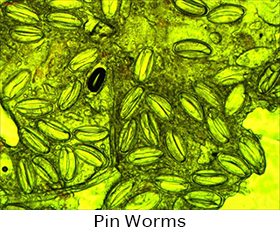 Dr. Byrd: In the past pinworms seemed to be a worm that was mainly seen in younger horses, however now it seems the occurrence seen in older horses appears to be increasing. We used to feel that deworming with Ivermectin was effective against pinworms but sometimes it no longer works and the horse continues to rub the tail head area. So, the owner need to use benzimidazoles or Pyrantel Pamoate. Pinworms are responsible for the saying, “My horse must have worms because it is rubbing its tail”.
Dr. Byrd: In the past pinworms seemed to be a worm that was mainly seen in younger horses, however now it seems the occurrence seen in older horses appears to be increasing. We used to feel that deworming with Ivermectin was effective against pinworms but sometimes it no longer works and the horse continues to rub the tail head area. So, the owner need to use benzimidazoles or Pyrantel Pamoate. Pinworms are responsible for the saying, “My horse must have worms because it is rubbing its tail”.
Horses with weak immune systems, such as the very young and very old or horse that have become debilitated through lack of care and nutrition.
Dr. Byrd: This was discussed under the competition horse and what occurred to cause sudden increase in the number of eggs a horse sheds when the immune system is impeded. I think the same things are in play here except the stress is likely to be much greater allowing for an increase in worm egg production.
Bot flies
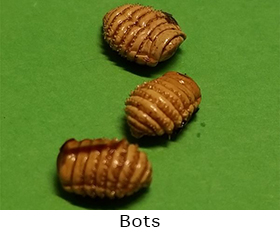 Dr. Byrd: The worms that we call bots are actually the larvae of a fly that resembles a honeybee. These flies buzz around the legs and other areas of the horse’s body and quickly dart in and lay eggs on the hair. The eggs can be seen and should be scraped off to reduce the number of larvae that get into the stomach. The eggs hatch and attach to the tongue, get into the mouth of the horse and migrate to the stomach where they stay until the following Spring. Consequently the best time to deworm for them is in late fall of early winter to kill the larvae while they are in the stomach. Ivermectin or moxidectin is the drug of choice. The bot flies cannot eat therefore they die off soon after all their eggs are laid generally in the early Fall.
Dr. Byrd: The worms that we call bots are actually the larvae of a fly that resembles a honeybee. These flies buzz around the legs and other areas of the horse’s body and quickly dart in and lay eggs on the hair. The eggs can be seen and should be scraped off to reduce the number of larvae that get into the stomach. The eggs hatch and attach to the tongue, get into the mouth of the horse and migrate to the stomach where they stay until the following Spring. Consequently the best time to deworm for them is in late fall of early winter to kill the larvae while they are in the stomach. Ivermectin or moxidectin is the drug of choice. The bot flies cannot eat therefore they die off soon after all their eggs are laid generally in the early Fall.
Habrodema
Dr. Byrd: These worms are the cause of a rather dramatic problem often referred to as a summer sore, they can be small to large (1/2-4 inches in diameter draining ulcer). The adult habrodema small worm lives in the stomach wall. They produce very thin walled eggs with embryos that can be seen. When the eggs hatch, the larvae are eaten by certain flies. When the fly feeds on the horse at the mucus membrane skin junction or at small injury sites, the larvae leave the fly and migrate into skin or wound. Some horses appear to have propensities to have a severe reaction to this larvae that cause the ulcer to grow rapidly. These are difficult to treat but do seem to heal during cold weather when flies disappear from the horses’ environment. Ivermectin was effective in the past but some resistance may be developing. However just deworming your horse is not a sure cure because the flies may pick up the larvae from other horses and then feed on your horse allowing the larvae to escape to your horse. However, treating a horse with Ivermectin on a monthly schedule for 3 months may help to limit the size of the ulcer.
CH: Thank-you for your time and advice Dr. Byrd. You have been very helpful. Is there anything else you’d like to add?
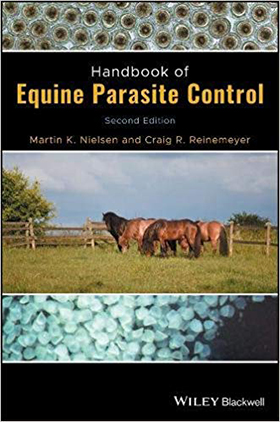 Dr. Byrd: Thank-you. Yes, please remember the information used in these answers has come from both my personal experience in the field and data from Horsemen’s Laboratory over 25 years and from Dr. Martin K. Nielsen and Craig R. Reinemeyer, experts in equine parasitology. I highly recommend their book 2nd Edition Handbook of Equine Parasite Control published by Wiley Blackwell which is available through Amazon.
Dr. Byrd: Thank-you. Yes, please remember the information used in these answers has come from both my personal experience in the field and data from Horsemen’s Laboratory over 25 years and from Dr. Martin K. Nielsen and Craig R. Reinemeyer, experts in equine parasitology. I highly recommend their book 2nd Edition Handbook of Equine Parasite Control published by Wiley Blackwell which is available through Amazon.
Indeed this book is a great read, and it is surprising that many field vets have not embraced the FECT as a cornerstone of a good horse worm control program. Obviously other factors such as management of manure on pastures, overgrazing, herd division and management of high worm egg count shedders all play an important role. A matter that Nielsen and Reinemeyer addressed in their preface to the 1st edition of their book,
“This book was conceived through the authors’ realization that equine practitioners were not likely to achieve competence in evidence based parasite control by reading journal length articles or by attending a few hours of continued education.”
The topic of equine parasitology is a complex one and relying on a vet who has proven experience as a specialist in FECT makes much sense. Horsemen’s Laboratory offers easy mail in sample kits for purchase online. You can then collect equine fecal samples and pop it in the post. It saves a vet call out fee, and you can control your targeted worm control program yourself based on the reports provided by Horsemen’s Laboratory and one on one advice from Dr. Byrd himself.
If you’ve already done this bravo, you are part of a sustainable solution to the dewormer resistant problem and are taking responsibility. Don’t forget to re-test after treatments! Horsemen’s Laboratory can put you on automatic sample kit delivery service and provide you with email reminders and reports to help keep you on track.
Please don’t hesitate to call Dr. Byrd at Horsemen’s Laboratory at 217-586-2004 for sample kits and advice. He is a friendly, knowledgeable vet that is a wealth of information and a great resource to help you ensure the optimal health of your horse.
Dr. John Byrd, the owner of Horsemen’s Laboratory, has a lifetime of experience with horses. As a child until entering college he showed horses in pleasure and reining class. During college, Dr. Byrd developed an interest in Running Quarter Horses that included breeding, owning, and racing in eight states. He graduated from the University of Illinois College of Veterinary Medicine and was selected for the first large-animal medical residency at the University of Florida in 1977. During his junior year, he received the Illinois Standard bred Breeders award for the student most interested in equine medicine. As an equine medicine practitioner in California for 13 years, Dr. Byrd served as ex-officio member of the board of directors of the Pacific Coast Quarter Horse Racing Association where he also served as the organization’s official sales veterinarian. In addition, Dr. Byrd frequently officiated as veterinarian for horse shows sponsored by the management of Orange County Fairgrounds in Costa Mesa, California. Dr. Byrd’s extensive experience with horses led him to observe how a horse’s health could impact performance and out of that Horsemen’s Laboratory was established in 1993.



